
The coral reefs: a rainbow-colored world
Coral, of which there are almost 1,000 species, is made up of polyp colonies. These minuscule soft-bodied animals are related to sea anemones. The polyps secrete calcium, a hard substance that forms an actual armor. When a polyp dies, its calcium exoskeleton remains intact. Thousands of generations of dead polyps pile up in this way to form the world’s great reefs. With a surface area of 344,000 km2, Australia’s Great Barrier Reef is the largest structure ever built by living creatures. Coral reefs grow mainly in shallow tropical waters. They attract a multitude of animals that find food and shelter there. It is believed that almost one-quarter of all the fish species live in these fragile environments, threatened by pollution, global warming and overfishing.
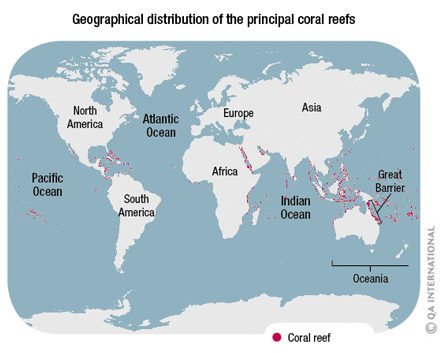 |
Coral and algae, a vital partnershipEach polyp in a coral colony measures only a few millimeters in size and has a central mouth surrounded by venomous tentacles. These allow the polyp to feed on minuscule prey. Hard coral, the kind that builds reefs, lives in partnership with microscopic algae (zooxanthellae) found only in warm, clear and shallow seas. The splendid colors of the reefs come from these algae, which supply the corals with the oxygen and nutrients they need in order to grow. In return, the algae use the corals as support and their waste as fertilizer to help them grow. Coral reefs are among the richest ecosystems, in terms of biodiversity. It is estimated that 1 to 9 million species live on them! Soft coral, which does not form reefs, is less abundant. It is deprived of algae and can grow in colder and deeper waters. |
 |
|
|
Coral reefs faunaThe crown-of-thorns starfishThe crown-of-thorns is a species of starfish that is taking over coral reefs in the Indian and Pacific oceans. These animals, equipped with long venomous spines, can measure 40 cm in diameter. They destroy the coral to feed on the soft polyps hidden inside. These starfish can cause the destruction of large areas of coral reef. |
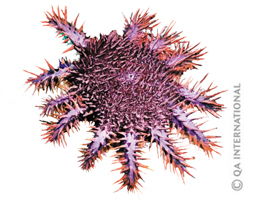 |
The surgeonfishThere are almost 80 species of surgeonfish. When they feel threatened, these tropical fish change color and the special spines on their tail stand on end. These spines are as sharp as scalpels and coated in a toxic mucus. Surgeonfish play an important role in the ecosystem of a reef by eating the surplus algae covering the coral. |
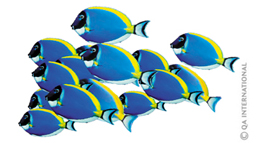 |
The clownfish and the sea anemoneThe colorful little clownfish finds refuge in the venomous tentacles of the sea anemone, an animal that is frequently found attached to the coral reef. The body of the clownfish is coated in a sticky layer that protects it from the anemone’s venom. The clownfish’s predators do not dare to attack it in its refuge. In compensation, the clownfish defends the anemone from the predators that feed on it. |
 |
The cleaner wrasseThe cleaner wrasse lives in the Indian and Pacific oceans where it feeds on parasites that encumber the mouth, fins, scales and gills of the other reef fishes. The maintenance that this small fish, which measures about 10 cm in length, provides is so appreciated that fish wait in line for its services. Cleaner wrasses can serve more than 2,000 “customers” a day! This relationship that benefits both parties is called mutualism. |
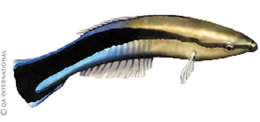 |
The parrotfishParrotfish are brilliantly colored tropical fish that measure about 40 cm long. They have an imposing dentition that forms a sort of hooked beak, which is where they get their name. These strong teeth allow them to finely grind the seaweed and coral that they eat. Once the coral is digested, it is transformed into white sand. A single parrotfish excretes tens of kilograms of white sand each year, which significantly contributes to the formation of tropical beaches. |
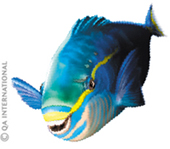 |
The porcupine fishWhen it feels threatened, the porcupine fish fills its stomach with water and blows up like a balloon. Its spines, which are usually flattened against its body, stand on end. This carnivore, measuring 50 to 60 cm long on average, frequents the coral reefs and shallow coastal waters of the Indian, Pacific and Atlantic oceans. |
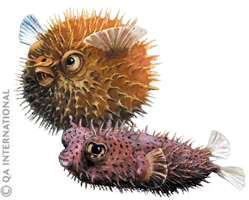 |
The sea snakeThe family of sea snakes comprises more than 60 species, which live in the warm coastal waters of the Indian and Pacific oceans. These reptiles, most of which measure between 1 and 1.5 m in length, have a tail flattened like a paddle that allows them to swim easily. Sea snakes have an extremely dangerous venom that is much more powerful than that of any land snake. |
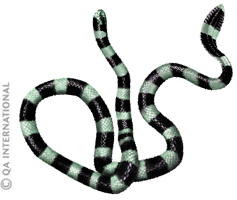 |
The giant clamThe giant clam lives in the coral reefs of the Indian and Pacific oceans. More than 1 m wide and weighing about 200 kg, it is the largest shellfish in the world. This gigantic mollusk eats microscopic algae that it cultivates inside its own shell. The giant clam can live more than 100 years! |
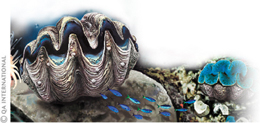 |
The spongeSponges are very simple and ancient creatures. They were among the first animals that evolved on Earth, hundreds of millions of years ago. There are about 9,000 species of different sizes and shapes that live attached to a variety of supports, including rocks and coral reefs. These immobile animals are covered in pores that absorb large amounts of water, supplying them with the oxygen and food they need. |
 |
Coral reef bleaching
One of the signs of a deteriorating reef is bleaching. This is caused by global warming and marine pollution that leads to the acidification of water and the disappearance of zooxanthellea, which are the minuscule algae that live in partnership with the corals. Unable to survive without this algae, the corals turn white and then die. It is estimated that almost 60 percent of the world’s coral reefs are endangered because of human activities (pollution, global warming, harmful fishing techniques, etc.).
Also see:
In the Visual Dictionary:
- "Animal Kingdom" section
- "Vegetable Kingdom" section
In the encyclopedic capsules :
- Islands, treasure chests of biodiversity
- The fauna and flora of polar regions: Antarctic
- The fauna and flora of polar regions: Arctic
- The food chain of living things
- The octopus, a cunning and clever animal !
- The spider, a web master
- The frog, queen of the metamorphosis
- The bee
- Marsupials
- The primates
- The bat
- The lobster
- The snail
- Fishes: from ocean to our plate





